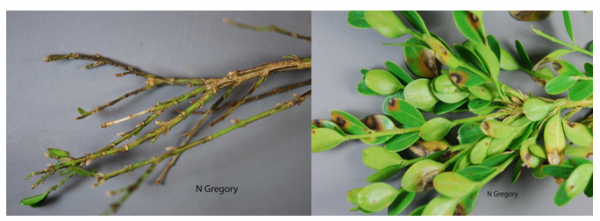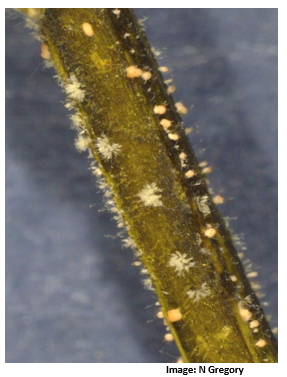
Fact Sheets And Publications

Boxwood Blight
The fungus Calonectria pseudonaviculata (Cylindrocladium pseudonaviculatum) causes severe defoliation and death of container grown boxwoods, and dieback in in-ground plantings. Most boxwood species are susceptible, including American and English boxwood (Buxus sempervirens), little leaf boxwood (B. microphylla) and hybrids such as B. sinica. Pachysandra is a host, and can be a source of spores capable of causing new infections. Sweetbox (Sarcococca) has also been identified as a host. There are a number of other diseases that affect boxwood, and environmental stress plays a role in susceptibility and predisposition to disease. Timely and accurate identification by microscopy is important for management of this aggressive disease.
Boxwood blight was first identified in the United Kingdom in 1994 and then in the U.S. in October of 2011. The disease has been identified in nurseries and landscapes on boxwood and pachysandra throughout the Eastern U.S. In June, 2013, boxwood blight was identified in a retail nursery in Delaware, and has been detected subsequently in retail operations, but destroyed.

Boxwood Blight - twigs showing blackened areas and leaf drop; Leaf spots due to boxwood blight.
Cylindrocladium is favored by temperatures between 18 and 25 C and by high humidity and rainfall. Early symptoms include brown leaf spots or tip blight, which can be rather inconspicuous. Twigs and stems later develop black streaks and leaves drop. In humid weather conditions or after incubation of samples in a moist chamber, signs of the fungal pathogen may be seen with a hand lens or a microscope. Signs include white clusters of spores of the fungus. It is very important to have this disease accurately identified due to similarity with other diseases, especially Volutella blight, which has been common in Delaware for many years. Volutella blight is most often associated with boxwood plants under environmental stress, whereas Cylindrocladium can affect healthy plants.
Spore masses of Volutella are pink to orange in color. There is no good control for Volutella except to trim out and reduce stress on plants. Boxwood blight, however, can be severe and lead to death of infected plants, and requires control measures.
Spore masses of Cylindrocladium (white) and Volutella (orange) 50x magnification
Management and Control of Boxwood Blight
 Control is dependent on rapid and accurate diagnosis. Diseased plants should be removed and destroyed if in a retail or nursery situation. Boxwood within 10 feet of affected plants should also be removed. Make sure to clean up all debris and leaves, as sanitation is very important to remove plant material containing spores. The pathogen can survive as resistant microsclerotia for several years in soil and debris, so infected material should not be composted. Following removal of affected material, pruning and sanitation of remaining area, fungicides can be used to protect new growth and unaffected plants nearby. Pruners and tools should be cleaned with bleach or alcohol. Avoid overhead irrigation. Do not bring new boxwood into established landscape plantings without inspection.
Control is dependent on rapid and accurate diagnosis. Diseased plants should be removed and destroyed if in a retail or nursery situation. Boxwood within 10 feet of affected plants should also be removed. Make sure to clean up all debris and leaves, as sanitation is very important to remove plant material containing spores. The pathogen can survive as resistant microsclerotia for several years in soil and debris, so infected material should not be composted. Following removal of affected material, pruning and sanitation of remaining area, fungicides can be used to protect new growth and unaffected plants nearby. Pruners and tools should be cleaned with bleach or alcohol. Avoid overhead irrigation. Do not bring new boxwood into established landscape plantings without inspection.
Chemical Control Options
Check with your state Department of Ag or County Agent regarding labeled fungicides. Preventive applications are helpful on asymptomatic plants or on plants near confirmed cases. Fungicide spray coverage needs to be very thorough due to the dense canopy of boxwood plants. It is recommended that plants be pruned first and then sprayed with the high rate of chemical according to label. There are no effective curative treatments. Use of mixtures of multiple active ingredients and rotation of chemistries to avoid development of resistance. A spreader/sticker is suggested. Chlorothalonil is a good protectant product to use. Some spray program options include:
- Pageant at 8-12 oz/100gal + chlorothalonil (or mancozeb) (Pageant is boscalid and pyraclostrobin in a combination). Use no more than 2 consecutive sprays
- Medallion (fludioxonil) 4 oz/100gal + mancozeb (or chlorothalonil)
- Chlorothalonil 1.375 pints/100gal or mancozeb
Reference to commercial products or trade names does not imply endorsement by University of Delaware Cooperative Extension.
For more information please see the following websites of American Hort (ANLA and OFA) and the Connecticut Agricultural Experiment Station: www.BoxwoodBlight.org
http://www.ct.gov/caes/cwp/view.asp?a=3756&q=500388
For answers to questions or assistance with diagnosing boxwood blight, please contact:
Delaware Department of Agriculture’s Nursery Inspection Unit, Plant Industries
(302)698-4583
Boxwood plant samples with suspect blight symptoms can be submitted to:
University of Delaware Plant Diagnostic Clinic
University of Delaware, Townsend Hall, 531 S. College Ave., Newark, DE 19716
(302) 831-1390
Author(s):
Nancy Gregory
Revision Date:
7/6/2018
Original Publication Date: June 2013
This institution is an equal opportunity provider.
UD Cooperative Extension
This institution is an equal opportunity provider.
In accordance with Federal law and U.S. Department of Agriculture policy, Cooperative Extension is prohibited from discriminating on the basis of race, color, national origin, sex, age, or disability.
